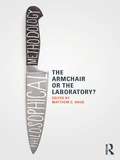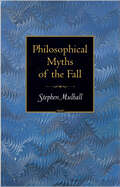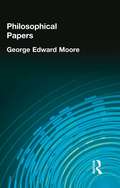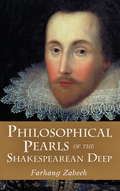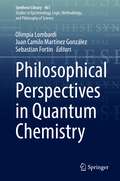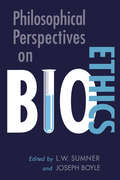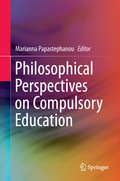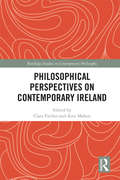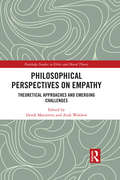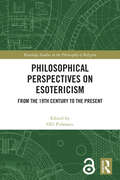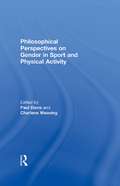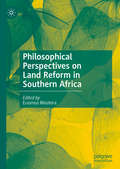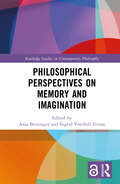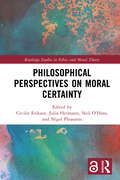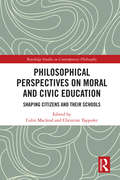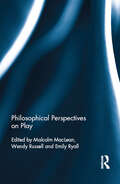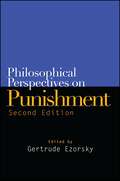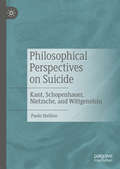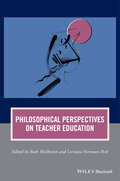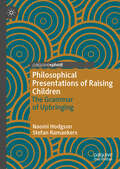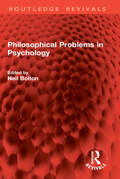- Table View
- List View
Philosophical Methodology: The Armchair Or The Laboratory?
by Matthew C. HaugWhat methodology should philosophers follow? Should they rely on methods that can be conducted from the armchair? Or should they leave the armchair and turn to the methods of the natural sciences, such as experiments in the laboratory? Or is this opposition itself a false one? Arguments about philosophical methodology are raging in the wake of a number of often conflicting currents, such as the growth of experimental philosophy, the resurgence of interest in metaphysical questions, and the use of formal methods. This outstanding collection of specially-commissioned chapters by leading international philosophers discusses these questions and many more. It provides a comprehensive survey of philosophical methodology in the most important philosophical subjects: metaphysics, epistemology, philosophy of language, philosophy of mind, phenomenology, philosophy of science, ethics, and aesthetics. A key feature of the collection is that philosophers discuss and evaluate contrasting approaches in each subject, offering a superb overview of the variety of methodological approaches - both naturalistic and non-naturalistic - in each of these areas. They examine important topics at the heart of methodological argument, including the role of intuitions and conceptual analysis, thought experiments, introspection, and the place that results from the natural sciences should have in philosophical theorizing. The collection begins with a fascinating exchange about philosophical naturalism between Timothy Williamson and Alexander Rosenberg, and also includes contributions from the following philosophers: Lynne Rudder Baker, Matt Bedke, Greg Currie, Michael Devitt, Matthew C. Haug, Jenann Ismael, Hilary Kornblith, Neil Levy, E.J. Lowe, Kirk Ludwig, Marie McGinn, David Papineau, Matthew Ratcliffe, Georges Rey, Jeffrey W. Roland, Barry C. Smith, Amie L. Thomasson, Valerie Tiberius, Jessica Wilson, and David W. Smith.
Philosophical Myths of the Fall (Princeton Monographs in Philosophy #18)
by Stephen MulhallDid post-Enlightenment philosophers reject the idea of original sin and hence the view that life is a quest for redemption from it? In Philosophical Myths of the Fall, Stephen Mulhall identifies and evaluates a surprising ethical-religious dimension in the work of three highly influential philosophers--Nietzsche, Heidegger, and Wittgenstein. He asks: Is the Christian idea of humanity as structurally flawed something that these three thinkers aim simply to criticize? Or do they, rather, end up by reproducing secular variants of the same mythology? Mulhall argues that each, in different ways, develops a conception of human beings as in need of redemption: in their work, we appear to be not so much capable of or prone to error and fantasy, but instead structurally perverse, living in untruth. In this respect, their work is more closely aligned to the Christian perspective than to the mainstream of the Enlightenment. However, all three thinkers explicitly reject any religious understanding of human perversity; indeed, they regard the very understanding of human beings as originally sinful as central to that from which we must be redeemed. And yet each also reproduces central elements of that understanding in his own thinking; each recounts his own myth of our Fall, and holds out his own image of redemption. The book concludes by asking whether this indebtedness to religion brings these philosophers' thinking closer to, or instead forces it further away from, the truth of the human condition.
Philosophical Papers
by Moore, George EdwardFirst published in 2002. Routledge is an imprint of Taylor & Francis, an informa company.
Philosophical Pearls of the Shakespearean Deep
by Farhang ZabeehOffers many fresh insights that will give even longtime readers of Shakespeare a new appreciation of the great master.Scholars have long debated the extent of Shakespeare's education. Although his friend and admirer Ben Jonson said of him, "thou hadst small Latine and lesse Greek," Shakespeare's plays reveal a wide familiarity with literary and philosophical works from the Renaissance, the Middle Ages, and the classical age. Philosopher Farhang Zabeeh delves into this fascinating topic in this detailed study of the philosophical influences evident in Shakespeare's plays and sonnets. Readers will be surprised and delighted to discover in Shakespeare unmistakable echoes of Plato, Aristotle, Cicero, Dante, Montaigne, and other famous thinkers. In one chapter, the author makes a convincing case that one of the bard's most famous comic characters, John Falstaff, is a parody of Socrates. In other chapters, he demonstrates indirect references to Plato in Shakespearean passages concerning appearance versus reality, as well as the influence of Aristotle's ethics. Other common philosophical themes evident in the plays concern the nature of time, subjectivity versus objectivity, and political and moral values. This new work offers many fresh insights that will give even longtime readers of Shakespeare a new appreciation of the great master.
Philosophical Perspectives in Quantum Chemistry (Synthese Library #461)
by Olimpia Lombardi Sebastian Fortin Juan Camilo Martínez GonzálezThis book explores the philosophy and the foundations of quantum chemistry. It features chapters written by experts in the field. The contributions analyze quantum chemistry as a discipline, in particular, its relation with both chemistry and physics from the viewpoint of realism and reduction. Coverage includes such topics as quantum chemistry as an “in-between” discipline, molecular structure and quantum mechanics, quantum chemical models, and atoms and molecules in quantum chemistry.The interest of this book is twofold. First, the contributions aim to update and refresh the discussions regarding the foundations of quantum chemistry. Second, they seek to develop new philosophical perspectives that this discipline can suggest to philosophers of science.From its origins, quantum chemistry filled a problematic position in the disciplinary space. On the one hand, it is a branch of theoretical chemistry. On the other hand, it appeals essentially to theoretical tools coming from physics. This peculiar position triggered conceptual questions about its own identity. Inside this book, readers will find updated discussions on the foundations and the philosophy of this complex discipline.
Philosophical Perspectives on Bioethics
by L. Wayne Sumner Joseph BoyleHow should we attempt to resolve concrete bioethical problems? How are we to understand the role of bioethics in the health care system, government, and academe? This collection of original essays raises these and other questions about the nature of bioethics as a discipline. The contributors to the volume discuss various approaches to bioethical thinking and the political and institutional contexts of bioethics, addressing underlying concerns about the purposes of its practice. Included are extended analyses of such important issues as the conduct of clinical trials, euthanasia, justice in health care, the care of children, cosmetic surgery, and reproductive technologies.
Philosophical Perspectives on Brain Data
by Stephen RaineyWhere there is data there are questions of ownership, leaks, and worries about misuse. When what’s at stake is data on our brains, the stakes are high. This book brings together philosophical analysis and neuroscientific insights to develop an account of ‘brain data’: what it is, how it is used, and how we ought to take care of it. Emerging trends in neuroscience appear to make mental activity legible, through sophisticated processing of signals recorded from the brain. This can include Artificial Intelligence (AI), with algorithms classifying brain signals for further processing. These developments will have ramifications for concepts of the brain, the self, and the mind. They will also affect clinical practices like psychiatry, by modifying concepts of mental health and introducing AI-based diagnostic and treatment strategies. The issues arising are vastly complicated, little understood, but of high importance. Philosophical Perspectives on Brain Data clarifies complex intersections of philosophical and neuroscientific interest, presenting an account of brain data that is comprehensible. This account can be the basis for evaluating practices based on brain data. As such, the book aims to open a novel space for evaluating hitherto arcane areas of academic research in order to provide the necessary scope for understanding their real-world consequences. These consequences will include personal, socio-political, and public health dimensions. It is therefore vital that they are understood if their impacts upon aspects of everyday life can be evaluated adequately.
Philosophical Perspectives on Compulsory Education
by Marianna PapastephanouFrom antiquity to the present, schools of some form have, in one way or other, been involved in the material and symbolic reproduction of societies. Such diachronic resilience, along with the synchronic omnipresence of schooling often makes schools appear as natural, self-evident and unavoidable. This naturalization of schooling is then extended to its modern specification as compulsory in a universalist fashion. This book does not only seek to explore what is left of older debates on compulsory education in the years' hindsight but also to associate the discussion of schooling with new theoretical developments and new emphases. It contains a first part, which operates, primarily, at the conceptual and justificatory level and reserves a, more or less, qualified welcome to a revisited notion of compulsory. And it supplements this first part with a second, more applied one that focuses on specific aspects of compulsory schooling and/or education. From Luther down to John Stuart Mill and John Dewey, compulsory education has been heralded either as a vehicle of social coordination and individual well-being, or as a vehicle of democratization and progress, or as a means for protecting the rights of the young and of society, and so on and so forth. But there have also been periods of challenge and denaturalization of compulsory education, producing a range of interesting and spirited debates not only on matters of educational legality but also on matters that boil down to broader philosophical questions about the self and the world. Without neglecting the lasting significance of older debates, argumentation over schooling, its character and its scope can be recast in the light of current philosophical educational debates. Given the fact that failure adequately to mine such connections leads to a lack in philosophical-educational engagement with one of the most central pedagogical practices of the contemporary world, namely, the school, the book aspires to remedy this lack and to put together work that addresses those connections through the highly original and innovative work of its contributors. The subtext in all contributions is a vision of educational transformation in one way or other. All chapters (from the most theoretical to the most practice-related) promote a version of a recast or redirected compulsory schooling.
Philosophical Perspectives on Contemporary Ireland (Routledge Studies in Contemporary Philosophy)
by Clara Fischer Áine MahonThis is the first book to bring a philosophical lens to issues of socio-political and cultural importance in twenty-first century Ireland. While the social, political, and economic landscape of contemporary Ireland has inspired extensive scholarly debate both within and well beyond the field of Irish Studies, there is a distinct lack of philosophical voices in these discussions. The aim of this volume is to enrich the fields of Philosophy and Irish Studies by encouraging a manifestly philosophical exploration of contemporary issues and concerns. The essays in this volume collectively address diverse philosophical questions on contemporary Ireland by exploring a variety of themes, including: diaspora, exile, return; women’s bodies and autonomy; historic injustices and national healing; remembering and commemoration; institutionalization and containment; colonialism and Ireland as "home"; conflict and violence; Northern Ireland and the peace process; nationalism, patriotism, and masculinities; ethnicity, immigration, and identity; and translation, art and culture. Philosophical Perspectives on Contemporary Ireland marks a significant contribution to contemporary theorizations of Ireland by incorporating both Irish and transatlantic perspectives. It will appeal to a broad audience of scholars and advanced students working in philosophy, Irish Studies, feminist theory, history, legal studies, and literary theory. Beyond academia, it will also engage those interested in contemporary Ireland from policy and civil society perspectives.
Philosophical Perspectives on Democracy in the 21st Century
by Ann E. Cudd Sally J. ScholzThis work offers a timely philosophical analysis of fundamental principles of democracy and the meaning of democracy today. It explores the influence of big money and capitalism on democracy, the role of information and the media in democratic elections, and constitutional issues that challenge democracy in the wake of increased threats to privacy since 2001 and in light of the Citizens United decision of the US Supreme Court. It juxtaposes alternate positions from experts in law and philosophy and examines the question of legitimacy, as well as questions about the access to information, the quality of information, the obligations to attain epistemic competence among the electorate, and the power of money. Drawing together different political perspectives, as well as a variety of disciplines, this collection allows readers the opportunity to compare different and opposing moral and political solutions that both defend and transform democratic theory and practice.
Philosophical Perspectives on Empathy: Theoretical Approaches and Emerging Challenges (Routledge Studies in Ethics and Moral Theory)
by Anik Waldow Derek MatraversEmpathy—our capacity to cognitively or affectively connect with other people’s thoughts and feelings—is a concept whose definition and meaning varies widely within philosophy and other disciplines. Philosophical Perspectives on Empathy advances research on the nature and function of empathy by exploring and challenging different theoretical approaches to this phenomenon. The first section of the book explores empathy as a historiographical method, presenting a number of rich and interesting arguments that have influenced the debate from the Nineteenth Century to the present day. The next group of essays broadly accepts the centrality of perspective-taking in empathy. Here the authors attempt to refine and improve this particular conception of empathy by clarifying the intentionality of the perspective taker’s emotion, the perspective taker’s meta-cognitive capacities, and the nature of central imagining itself. Finally, the concluding section argues for the re-evaluation, or even rejection, of empathy. These essays advance alternative theories that are relevant to current debates, such as narrative engagement and competence, attunement or the sharing of mental states, and the "second-person" model of empathy. This book features a wide range of perspectives on empathy written by experts across several different areas of philosophy. It will be of interest to researchers and upper-level students working on the philosophy of emotions across ethics, philosophy of mind, philosophy of psychology, and the history of philosophy.
Philosophical Perspectives on Esotericism: From the 19th Century to the Present (Routledge Studies in the Philosophy of Religion)
by Pitkänen, Edited by OlliThis volume offers the first systematic philosophical study of esotericism and late modern philosophy. It addresses fundamental philosophical questions related to esotericism and reveals that esoteric ideas have had decisive impact on countless important philosophers, even if this fact has been neglected in contemporary philosophy.The first part of the book is dedicated to substantial and methodological questions. What is philosophy, what is esotericism, and how should we think about their relationship? The second section is more historically oriented, and it is divided in two parts. Part I is concerned with German romanticism and idealism, with a specific focus on the influence of esotericism on Hegel and Schelling, as well as the connection between romanticism and Kabbalah in the work of Gershom Scholem. Part II explores esotericism in phenomenology, pragmatism, and post-idealism, specifically in the work of William James, Martin Heidegger, Henri Bergson, and Roy Bhaskar.Philosophical Perspectives on Esotericism will appeal to scholars and advanced students working in philosophy of religion, history of philosophy, and religious studies.
Philosophical Perspectives on Gender in Sport and Physical Activity
by Paul Davis Charlene WeavingThere are a broad variety of sex and gender resonances in sport, from the clash of traditional ideas of femininity and athleticism represented by female athletes, to the culture of homophobia in mainstream male sport. Despite the many sociological and cultural volumes addressing these subjects, this collection is the first to focus on the philosophical writings that they have inspired. The editors have selected twelve of the most thought-provoking philosophical articles on these subjects from the past thirty years, to create a valuable and much needed resource. Written by established experts from all over the world, the essays in this collection cover four major themes: sport and the construction of the female objectification and the sexualization of sport homophobia sex boundaries: obstruction, naturalization and opposition. The book gathers a broad range of philosophical viewpoints on gender in sport into one unique source, subjecting the philosophical origins and characteristics of some of the most controversial topics in sport to rigorous scrutiny. With a balance of male and female contributors from both sides of the Atlantic, and a comprehensive introduction and postscript to contextualize the source material, Philosophical Perspectives on Gender in Sport and Physical Activity is essential reading for all students of the philosophy of sport, sport and gender, and feminist philosophy.
Philosophical Perspectives on Land Reform in Southern Africa
by Erasmus MasiteraThis edited collection explores a variety of philosophical perspectives on land reform in Southern Africa. Presenting an innovative focus on the philosophical themes in land reform, the contributors reflect on traditional African conceptualisations of the land, as well as Western interpretations, introducing specifically Southern African approaches to a wide range of debates. Rooted in questions of colonization and decolonization, the chapters examine what reform ought to do for the people of Africa, providing contemporary reflections on the different racial and cultural facets of the land. Notably, ideas of reconciliation, compensation, justice, development, emancipation, Ubuntu, and empowerment are explored. Vigorous and interdisciplinary in their approach, the fifteen original chapters tackle a range of questions such as: What does land mean in Africa? What ethical considerations are relevant? Which mechanisms should be used in addressing injustice regarding land reform and redistribution? Providing a comprehensive engagement with philosophical and political issues of land reform in Southern Africa, this volume is an invaluable resource to scholars, not only in Africa, but wherever similar questions of land, dispossession, and justice arise.
Philosophical Perspectives on Memory and Imagination (Routledge Studies in Contemporary Philosophy)
by Anja Berninger Íngrid Vendrell FerranThis book explores the structure and function of memory and imagination, as well as the relation and interaction between the two states. It is the first book to offer an integrative approach to these two emerging areas of philosophical research. The essays in this volume deal with a variety of forms of imagining and remembering. The contributors come from a range of methodological backgrounds: empirically minded philosophers, analytic philosophers engaging mainly in conceptual analysis, and philosophers informed by the phenomenological tradition. Part 1 consists of novel contributions to ontological issues regarding the nature of memory and imagination and their respective structural features. Part 2 focuses on questions of justification and perspective regarding both states. The chapters in Part 3 discuss issues regarding memory and imagination as skills or abilities. Finally, Part 4 focuses on the relation between memory, imagination, and emotion. Philosophical Perspectives on Memory and Imagination will be of interest to scholars and advanced students working in philosophy of memory, philosophy of imagination, philosophy of mind, and epistemology.
Philosophical Perspectives on Moral Certainty (Routledge Studies in Ethics and Moral Theory)
by Neil O'Hara Julia Hermann Nigel Pleasants Cecilie EriksenMoral certainty refers to those aspects of morality- moral acting, feeling, and thinking-that are beyond doubt, explanation, and justification. The essays in this book explore the concept of moral certainty and its application and usefulness in contemporary moral debates. The notion of moral certainty, which is inspired by the philosophy of Ludwig Wittgenstein, is emerging as a key reference point in contemporary moral philosophy. An investigation of the implications of moral certainty is called for, given that so many discussions in moral philosophy concern the possibility of justifying our moral beliefs. The concept of moral certainty also feeds directly into the emerging field of hinge epistemology. The chapters in this volume tackle the following issues: meta-questions around whether and how we can make sense of the concept of moral certainty; the role of moral certainty in contemporary debates on gender, racism, bias and historically unjust practices; ways in which radical change in society engendered by new technologies might affect moral certainties; the role of the notion of moral certainty in the debates on free will and moral responsibility. Philosophical Perspectives on Moral Certainty will appeal to researchers and advanced students working on ethics and moral philosophy, epistemology, philosophy of technology, and Wittgenstein.
Philosophical Perspectives on Moral and Civic Education: Shaping Citizens and Their Schools (Routledge Studies in Contemporary Philosophy)
by Colin Macleod Christine TappoletMany people place great stock in the importance of civic virtue to the success of democratic communities. Is this hope well-grounded? The fundamental question is whether it is even possible to cultivate ethical and civic virtues in the first place. Taking for granted that it is possible, at least three further questions that arise: What are the key elements of civic virtue? How should we cultivate these virtuous dispositions? And finally, how should schools be organized in order to make the education of citizen possible? These interrelated questions are the focus of this collection. By considering these questions from a variety of philosophical perspectives ranging from moral psychology, philosophy of education, and political philosophy, the nine essays assembled here advance our understanding of the challenges we face in trying to shape children to be virtuous citizens.
Philosophical Perspectives on Play
by Malcolm MacLean, Wendy Russell and Emily RyallPhilosophical Perspectives on Play builds on the disciplinary and paradigmatic bridges constructed between the study of philosophy and play in The Philosophy of Play (Routledge, 2013) to develop a richer understanding of the concept and nature of play and its relation to human life and value. Made up of contributions from leading international thinkers and inviting readers to explore the presumptions often attached to play and playfulness, the book considers ways that play in ‘virtual’ and ‘real’ worlds can inform understandings of each, critiquing established norms and encouraging scepticism about the practice and experience of play. Organised around four central themes -- play(ing) at the limits, aesthetics, metaphysics/ontology and ethics -- the book extends and challenges notions of play by drawing on issues emerging in sport, gaming, literature, space and art, with specific attention paid to disruption and danger. It is intended to provide scholars and practitioners working in the spheres of play, education, games, sport and related subjects with a deeper understanding of philosophical thought and to open dialogue across these disciplines.
Philosophical Perspectives on Punishment, Second Edition
by Gertrude EzorskyBringing together classic and contemporary texts, this collection considers general philosophical concepts about and justifications for punishment, along with particular issues such as the death penalty and possible alternatives to punishment. New to the second edition are sections on prison labor, solitary confinement, and issues relating to the punishment of people of color, women, and the poor. Drawing from philosophy, law, literature, and activism, Gertrude Ezorsky provides a comprehensive and up-to-date account of the philosophical issues underlying and growing out of punishment.
Philosophical Perspectives on Ruins, Monuments, and Memorials
by Carolyn Korsmeyer Jeanette Bicknell Jennifer JudkinsThis collection of newly published essays examines our relationship to physical objects that invoke, commemorate, and honor the past. The recent destruction of cultural heritage in war and controversies over Civil War monuments in the US have foregrounded the importance of artifacts that embody history. The book invites us to ask: How do memorials convey their meanings? What is our responsibility for the preservation or reconstruction of historically significant structures? How should we respond when the public display of a monument divides a community? This anthology includes coverage of the destruction of Palmyra and the Bamiyan Buddhas, the loss of cultural heritage through war and natural disasters, the explosive controversies surrounding Confederate-era monuments, and the decay of industry in the U.S. Rust Belt. The authors consider issues of preservation and reconstruction, the nature of ruins, the aesthetic and ethical values of memorials, and the relationship of cultural memory to material artifacts that remain from the past. Written by a leading group of philosophers, art historians, and archeologists, the 23 chapters cover monuments and memorials from Dubai to Detroit, from the instant destruction of Hiroshima to the gradual sinking of Venice.
Philosophical Perspectives on Suicide: Kant, Schopenhauer, Nietzsche, and Wittgenstein
by Paolo StellinoThis book aims to address in a novel way some of the fundamental philosophical questions concerning suicide. Focusing on four major authors of Western philosophy - Kant, Schopenhauer, Nietzsche, and Wittgenstein - their arguments in favour or against suicide are explained, contextualized, examined and critically assessed. Taken together, these four perspectives provide an illuminating overview of the philosophical arguments that can be used for or against one’s right to commit suicide. Intended both for specialists and those interested in understanding the many complexities underlying the philosophical debate on suicide, this book combines philosophical depth with exemplary clarity.
Philosophical Perspectives on Teacher Education (Journal of Philosophy of Education)
by Ruth Heilbronn Lorraine Foreman PeckPhilosophical Perspectives on Teacher Education presents a series of well-argued essays about the ethical considerations that should be addressed in teacher training and educational policies and practices. Brings together philosophical essays on an underserved yet urgent aspect of teacher education Explores the kinds of ethical considerations that should enter into discussions of a teacher’s professional education Illuminates the knowledge and understanding that teachers need to sustain their careers and long-term sense of well being Represents an important resource to stimulate contemporary debates about what the future of teacher education should be
Philosophical Presentations of Raising Children: The Grammar of Upbringing
by Naomi Hodgson Stefan RamaekersThis book uses contemporary film to articulate a philosophical account of raising children. It forms part of a revaluation of the parent as a pedagogical figure, which stands in contrast to the instrumental accounts dominant in contemporary ‘parenting’ culture. Hodgson and Ramaekers use film in order to offer an affirmative account of the experience of raising children, as a presentation of those inevitable aspects and experiences that upbringing is: the initiation into language and the world; the representative nature of the parent; and the maintaining of mundane practices that constitute our shared culture and community. The films which are discussed are taken as grammatical investigations and enable the authors to develop an account of the use of film in education and as educational philosophy, and to respond to each film’s invitation to articulate the existential dimensions of raising children. Philosophical Presentations of Raising Children will be of interest to students and scholars across a range of disciplines, including education, sociology, philosophy, critical parenting studies and film studies.
Philosophical Problems in Psychology (Routledge Revivals)
by Neil BoltonPhilosophical psychology reflects upon the aims and the concepts of empirical psychology. First published in 1979, Philosophical Problems in Psychology argues that empirical psychology must be founded upon the language of rationality, for actions and the reasons people give for their actions are at the heart of human behaviour.This thesis is defended in the contributions to Part I which assert that psychology must take the form of an elaboration of common sense. But the authors in Part II maintain that psychology may remain faithful to this insight whilst still developing more sophisticated models of behaviour. The use of computer models, Piaget’s views on the effects of internalization and a discussion of the geometry of phenomenal space provide illustrations. Part III contains three papers which explore the limitations of theoretical statements which emphasize our construction of reality. The pertinence of the computer analogy is disputed, subject-centred models are scrutinized in the light of phenomenology, and the role of theory in psychotherapy is critically discussed.
Philosophical Problems in Sense Perception: Testing the Limits of Aristotelianism (Studies in the History of Philosophy of Mind #26)
by David Bennett Juhana ToivanenThis volume focuses on philosophical problems concerning sense perception in the history of philosophy. It consists of thirteen essays that analyse the philosophical tradition originating in Aristotle’s writings. Each essay tackles a particular problem that tests the limits of Aristotle’s theory of perception and develops it in new directions. The problems discussed range from simultaneous perception to causality in perception, from the representational nature of sense-objects to the role of conscious attention, and from the physical/mental divide to perception as quasi-rational judgement. The volume gives an equal footing to Greek, Arabic, and Latin philosophical traditions. It makes a substantial contribution not just to the study of the Aristotelian analysis of sense perception, but to its reception in the commentary tradition and beyond. Thus, the papers address developments in Alexander of Aphrodisias, Themistius, Avicenna, John of Jandun, Nicole Oresme, and Sayf al-Din al-Amidi, among others. The result of this is a coherent collection that attacks a well-defined topic from a wide range of perspectives and across philosophical traditions.
